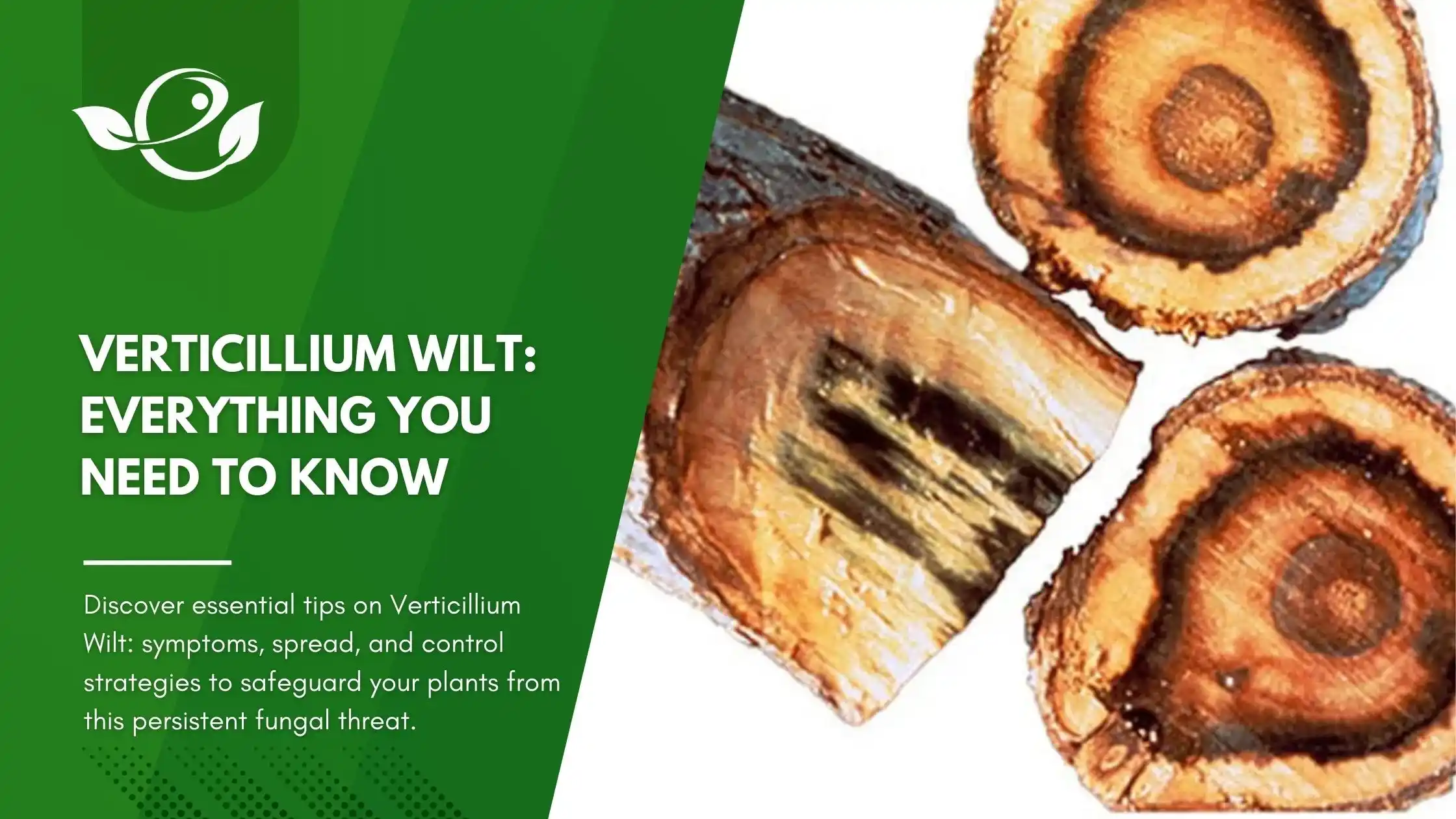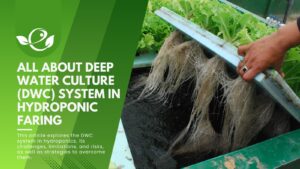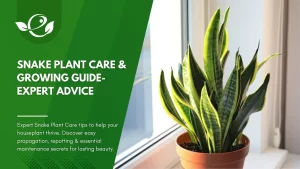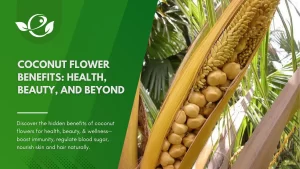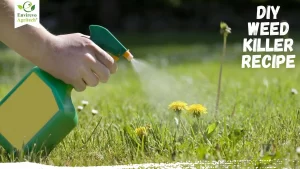Table of Contents
Verticillium wilt is one of the most destructive plant diseases, affecting a vast range of species, from towering trees to delicate garden flowers. Caused by soil-borne fungi (Verticillium dahliae and Verticillium albo-atrum), this disease disrupts the vascular systems of plants, leading to wilting, yellowing, and often death. Its resilience, aided by the long survival of fungal microsclerotia in the soil, makes it a persistent challenge for gardeners, farmers, and landscapers alike. Understanding its symptoms, pathways of infection, and strategies for management is essential to curb its devastating impact. This guide offers in-depth insights into Verticillium wilt, equipping you with the knowledge to identify, prevent, and manage this formidable adversary in your garden or farm.
What is Verticillium Wilt?
Verticillium wilt is a fungal disease that infects plants through their root systems. Once inside, the fungi colonize the plant’s xylem, blocking water and nutrient transport. This results in symptoms such as wilting, chlorosis, and stunted growth. The fungi persist in soil as microscopic structures called microsclerotia, which can survive for over a decade, making the disease particularly difficult to eradicate.
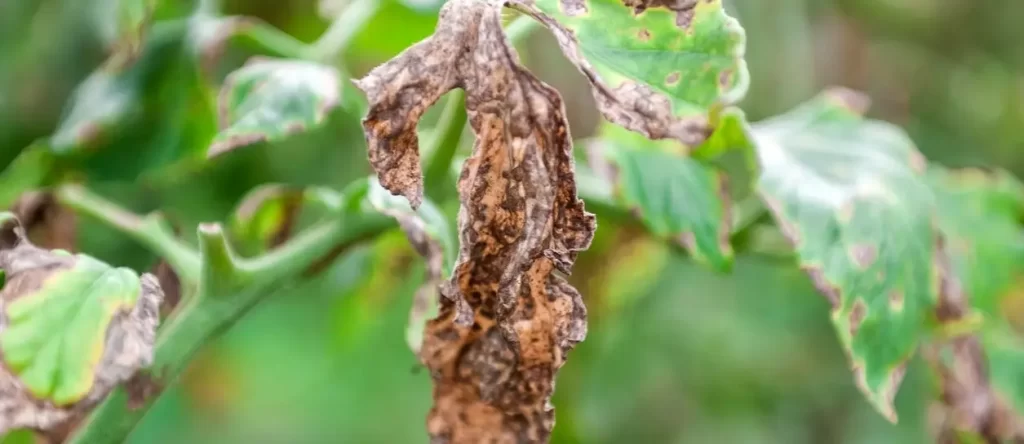
The symptoms are caused by a series of soil-borne fungi, among others V. dahliae, which can survive on crop debris in the soil when no host is available. It enters the vascular tissue of the plant through the rootlets or wounds in the bark. Once inside the plant or the tree, it grows rapidly and blocks the transport of water and nutrients, resulting in the wilting and decay of the aerial parts (leaves and stems). This is intensified by warm sunny weather. At later stages of the disease, the fungus colonizes the dying tissue and forms dark structures that can be observed with a magnifying lens. The fungus can survive several years at a location.[1]
The disease can manifest as either acute or chronic:
- Acute infections cause sudden wilting and death.
- Chronic infections lead to a gradual decline, with symptoms worsening over time.
Symptoms of Verticillium Wilt
Recognizing the symptoms of Verticillium wilt is crucial for early intervention. Symptoms vary greatly between the different crops. Key symptoms include:
- One-sided wilt: Usually, yellowing appears first on the margins of older leaves. As the yellowing extends to the rest of the tissue, the leaf takes a wilted aspect, often only on one side. This particular trait is called sectoral chlorosis or “one-sided wilt”.
- Chlorosis: Leaves develop yellow patches due to impaired nutrient flow, which may eventually spread to entire leaves. This yellowing often appears between the veins, creating a distinct pattern.
- Necrosis: Brown or black dead tissue develops on leaves, stems, or branches, starting at the edges and progressing inward. In severe cases, this can cause entire sections of the plant to die.
- Stunted Growth: Affected plants frequently fail to reach their full potential size, as the disease impairs their ability to transport essential nutrients and water effectively.
- Defoliation: Leaves may drop prematurely, sometimes in large clusters, leaving the branches bare and the plant weakened.
- Vascular Discoloration: Cutting into stems or roots often reveals brown, dark streaks or blackened vascular tissue, a hallmark diagnostic sign of Verticillium wilt. This discoloration can extend throughout the plant’s vascular system. Sometimes, at closer inspection with a lens, small black dots are visible in the dying tissue or on living tissue as well.
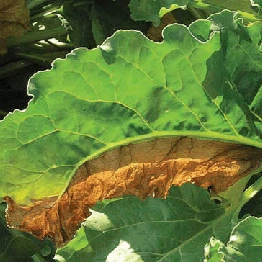
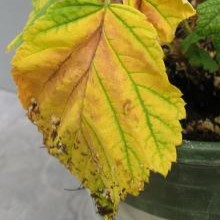
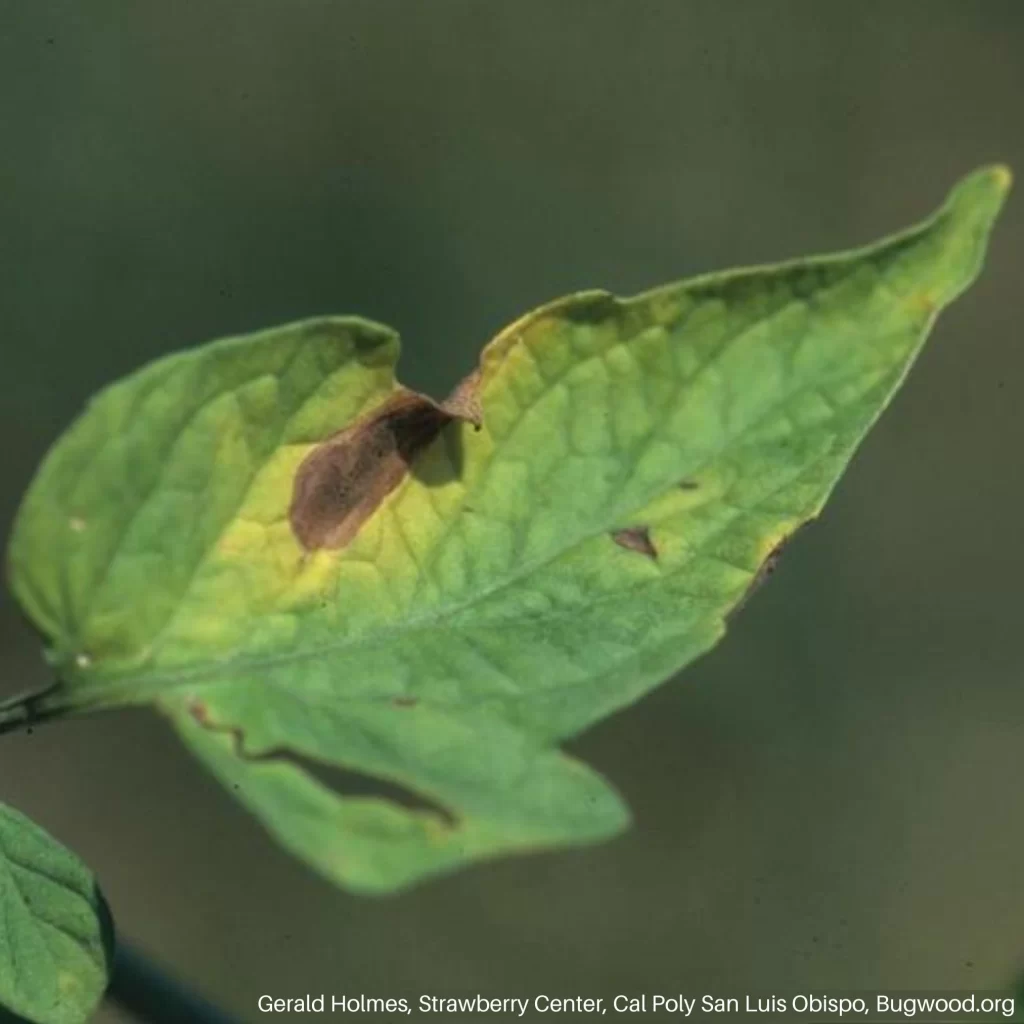

Additional Observations:
- Localized Symptoms: In some cases, symptoms are confined to a few branches or a specific part of the plant. This makes early detection challenging, as unaffected parts may appear healthy initially.
- Progression with Weather Conditions: Symptoms may worsen during hot, sunny periods when the plant’s water demand is higher. Cool, wet weather can temporarily mask symptoms, leading to delayed diagnosis.
- Recovery and Relapse Cycles: Some plants exhibit temporary recovery in cooler conditions, only to show severe symptoms later when stressed.
Distinguishing Characteristics in Different Plant Types:
- Trees and Shrubs: Wilting and dieback often occur on specific branches, giving the canopy a patchy appearance. Vascular discoloration is more prominent in woody plants.
- Vegetables: In crops like tomatoes and potatoes, symptoms include leaf curling, wilting, and fruit reduction. The plants may collapse entirely under severe infection.
- Herbaceous Plants: Flowers and ornamental plants like roses may exhibit stunted growth, chlorosis, and leaf necrosis, impacting their aesthetic appeal.
Late-Stage Symptoms:
In advanced cases, plants may experience significant dieback, leaving only the lower parts alive. The fungi further colonize the decaying tissue, producing microsclerotia that ensure survival in the soil for years, perpetuating the infection cycle.
By carefully observing these symptoms and their progression, gardeners and farmers can take timely action to mitigate damage and prevent further spread of Verticillium wilt.
Plants Susceptible to Verticillium Wilt
Verticillium wilt affects a wide range of plants, including:
- Trees and Shrubs: Maples, ash, elms, and magnolias.
- Vegetables: Tomatoes, potatoes, cucumbers, and eggplants.
- Flowers: Roses and chrysanthemums.
Resistant Plants
Some plants are naturally resistant to Verticillium wilt, making them ideal replacements in affected areas. Examples include:
- Conifers (e.g., pine and spruce)
- Ginkgo
- Crabapple
How Does Verticillium Wilt Spread?
Verticillium wilt spreads primarily through soil, plant debris, and water movement, making it a highly persistent and challenging pathogen to control. The fungi responsible for this disease (Verticillium dahliae and Verticillium albo-atrum) produce resilient structures called microsclerotia that can survive for years in the soil without a host plant. When a susceptible plant is introduced, the microsclerotia germinate and penetrate the roots, often through rootlets or wounds in the plant tissue.
Once inside the plant, the fungi invade the vascular system, particularly the xylem, where they rapidly colonize and obstruct water and nutrient transport. This blockage leads to wilting and eventual decay of the aerial parts of the plant. The fungi also produce secondary metabolites, including toxins, that exacerbate damage to plant tissues.
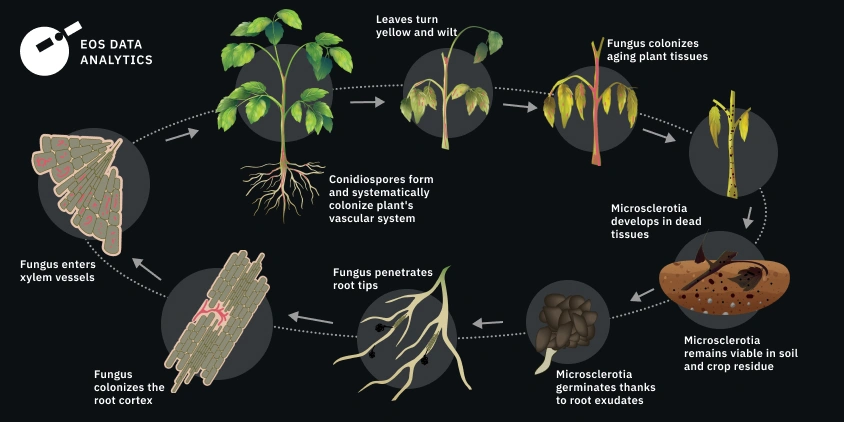
The impact of Verticillium wilt disease is most noticeable from spring to fall, when affected plants exhibit pronounced wilting symptoms. [3]
Infected plants contribute to the spread by shedding leaves, stems, or roots harboring the pathogen. Irrigation water or rain can carry spores and infected debris to new areas, expanding the disease’s reach. Additionally, contaminated tools or equipment used during pruning or soil preparation can inadvertently transfer the fungi to healthy plants.
Environmental conditions, such as warm, sunny weather, can intensify the disease’s progression, while cooler and moist conditions may temporarily mask symptoms, leading to delayed detection. Proper garden hygiene, crop rotation, and selecting resistant plant varieties are critical in minimizing the spread and impact of Verticillium wilt.
Management and Control of Verticillium Wilt
Managing Verticillium wilt requires an integrated approach that combines preventive strategies, immediate interventions, and long-term planning. The lack of a direct cure makes proactive measures essential to limit the disease’s spread and reduce its impact on susceptible plants.
1. Immediate Treatment Options
While curing Verticillium wilt in infected plants is not feasible, specific interventions can help manage the disease and limit its damage.
- Pruning and Removal: Cut back infected branches, stems, or shoots to slow disease progression. Always prune well below the affected areas and sterilize tools between cuts to prevent cross-contamination.
- Improved Soil Health: Amend soil with organic matter like compost or well-rotted manure to enhance microbial diversity. Beneficial microbes can suppress fungal populations, while improved soil structure aids plant resilience.
- Water and Nutrient Management: Ensure plants receive consistent moisture and adequate nutrition, as stressed plants are more vulnerable to the disease. Avoid overwatering, which can exacerbate root damage, and apply balanced fertilizers to promote plant vigor.
- Chemical Treatments: Although there are no fungicides specifically labeled for Verticillium wilt, certain soil fumigants or biofungicides may reduce fungal populations when applied professionally. However, these treatments can be costly and may have environmental limitations.
2. Biological Control Measures
- Biofungicide: Biofungicides containing Streptomyces lydicus break the life cycle of the fungus and can help to control the progression of the disease.
- Beneficial Soil Microbes: Introduce beneficial fungi or bacteria, such as Trichoderma species, which can compete with Verticillium and reduce its survival in the soil.
- Cover Crops and Green Manures: Use non-host cover crops like mustard or sorghum that release biofumigants when incorporated into the soil. These compounds suppress fungal populations and improve soil health.
3. Chemical Control
At this time, there is no known chemical control for this disease. Always consider an integrated approach with preventive measures together with biological treatments if available. When the trees are affected by the disease it is very difficult to get rid of it. Application of soil fumigants is an effective, but expensive control tactic. The effectiveness depends on the chemical used, the rate, and the environmental conditions at the time of application. Treatment of affected plant parts can also be envisaged.
4. Long-Term Strategies
For heavily infected sites or persistent outbreaks, implementing long-term solutions is necessary to restore the health of the area.
- Plant Resistant or Non-Host Species: Replace heavily affected plants with resistant alternatives to reduce the disease reservoir. For instance, replacing a diseased maple tree with a ginkgo tree can restore aesthetic value while breaking the infection cycle.
- Solarization of Soil: Solarization involves covering the soil with clear plastic during hot weather to trap heat and kill pathogens, including Verticillium microsclerotia. This method is particularly effective in sunny regions but requires consistent temperatures of 140°F (60°C) or higher for several weeks.
- Mulching: Apply a layer of organic mulch to suppress weeds and maintain soil moisture. Mulch can also limit the movement of fungal spores during irrigation or rainfall.
- Disinfection of Tools and Equipment: Always clean and disinfect garden tools, machinery, and containers used in infected areas. Use a solution of one part bleach to nine parts water to eliminate fungal spores.
- Avoid Soil Movement: Prevent the transfer of infected soil to clean areas by limiting activities such as digging or tilling. This is especially important in commercial farming or landscaping.
5. Professional Assistance
For large-scale outbreaks or valuable plants like mature trees, consulting an arborist or plant pathologist is advisable. Professionals can assess the extent of infection and recommend advanced management techniques, including soil fumigation or grafting with resistant rootstocks.
Prevention Strategies of Verticillium Wilt
Prevention is the cornerstone of managing Verticillium wilt, as the fungi’s ability to persist in soil for decades makes eradication nearly impossible.
- Soil Testing and Monitoring: Before planting, test soil in high-risk areas or sites with a history of wilt infections. Soil testing can detect the presence of Verticillium microsclerotia, enabling gardeners to take preventative measures early.
- Crop Rotation: Rotate susceptible crops with non-host plants such as cereals or grasses for at least three to five years. Crop rotation helps to starve the fungi and reduce their population in the soil.
- Resistant Varieties: Opt for plant varieties bred for resistance to Verticillium wilt. For example, certain tomato and potato cultivars have been developed to withstand the infection. In landscapes, replace susceptible trees and shrubs with resistant species like ginkgo, pine, or spruce.
- Quarantine Measures: Avoid introducing potentially infected plants or soil into clean areas. Carefully inspect new plants for signs of disease, and quarantine them before planting in the garden or field.
- Hygiene and Sanitation: Maintain strict garden hygiene by removing all plant debris, especially from previously infected areas. Diseased materials should be disposed of safely by burning or bagging, as composting can allow the fungi to persist.
- Avoid nitrogen-rich fertilizers and excess water.
- Use the plant fortifier to strengthen the plants against an infection.
- Clean all tools and equipment after handling infected plants.
- Do not work in fields when the foliage is wet.
You may also like:
- How To Get Rid Of Squash Bugs: 6 Effective Control Products
- Tussock Moth Control: Best Easy Treatment Options
- How to Get Rid of Broad-nosed Weevil?- Best Organic Control
- How to Get Rid of Thrips: Best 10 insecticide for thrips
- Best 9 Tips To Get Rid of Flea Beetles In Your Garden
- Pod Bug Damage Control: Top 10 Prevention Tips
FAQs About Verticillium Wilt
Can Verticillium wilt be cured?
There is no complete cure for Verticillium wilt. Management focuses on prevention and mitigation.
Is Verticillium wilt contagious?
Yes, it spreads through soil, water, and infected plant material.
How can I prevent it from spreading?
Practice crop rotation, remove infected plants, and maintain proper garden hygiene.
Can seeds carry Verticillium wilt?
Although rare, seeds from infected plants may carry the fungi. Purchasing certified disease-free seeds minimizes this risk.
Are indoor plants safe from Verticillium wilt?
Indoor plants are generally less susceptible due to controlled soil and environment. However, introducing contaminated soil or infected plants poses a risk.
Does Verticillium wilt affect pollinators or other beneficial organisms?
The fungi primarily target plants and do not directly harm pollinators or beneficial soil organisms.
Are there biological controls for Verticillium wilt?
Research into biological controls, such as using antagonistic fungi or beneficial microbes, shows promise. However, these methods are not widely available for home gardeners.
Final Thoughts
Verticillium wilt is a persistent and destructive plant disease that demands vigilance and proactive management. Its ability to infect a wide variety of plants and linger in the soil for years makes it a formidable adversary for gardeners and farmers alike. By understanding its symptoms, identifying susceptible and resistant plants, and implementing effective prevention and control strategies, you can significantly reduce the impact of this disease on your landscape.
While eradication is challenging, careful soil management, crop rotation, and the use of resistant plant varieties offer hope for maintaining healthy, thriving gardens and farms. Armed with knowledge and best practices, you can take meaningful steps to protect your plants from Verticillium wilt and ensure a flourishing environment for years to come.
